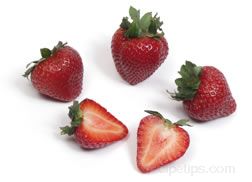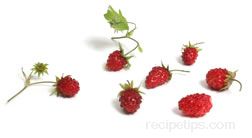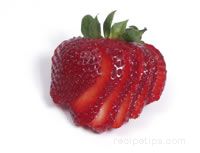|
Strawberry Preparation | Strawberry Garnish | Tips
| Strawberries |
|

Large, juicy, red berries that are very sweet when ripe and grow on a low-growing perennial plant that has horizontal runners that spread along the ground. The strawberry plants are generally replaced after 3 or 4 seasons to insure productivity of the crop. The berries that we eat are not actually the fruit. They are the swelling of the plant's stalk that happens after the flowers have been pollenated. The tiny seeds that cover the berries are actually the real fruit. There are hundreds of different varieties of cultivated strawberries, which vary in size, shape, juiciness, texture, and sweetness. There are also wild strawberries, which are smaller than the cultivated varieties, but they are juicier and more flavorful. Strawberries are harvested at different times throughout the year in different locations. California and Florida produce the majority of the strawberries in the United States. Strawberries are hign in vitamin C, manganese and dietary fiber. There also have a high rate of antioxidant power. |
|
Uses:
Ripe strawberries are often eaten raw as whole, sliced or crushed berries. When sugar is added to strawberries, their natural juices are drawn out and crushed berries will produce a sauce that can be eaten as is or poured over shortcake or ice cream. Strawberries are used as an ingredient in many salads, pies, cakes, sorbets, and other desserts. They are used as appetizers or a garnish on appetizer and cheese platters. A popular dessert is strawberries dipped in chocolate. Strawberries mixed in a blender with ice cream, yogurt, milk or other fruits make delicious and healthy shakes. They can also be cooked and made into jellies and jams. It is also one of the most popular flavorings in candies and other sweet products. Dried strawberries, which make sweet, chewy treats, are also quite common and are often added to snack mixes. |
| At Their Best:
Available year-round. Local markets generally have strawberries available through the summer months. |
|
How to Buy:
Look for strawberries that are a shiny, bright red color. Dull red berries are an indication that they are overripe. They should be firm without bruises or soft spots, which cause the berries to deteriorate quickly and contaminate the other berries. Always check the entire container of strawberries, top and bottom, to avoid purchasing berries that are dull, bruised, or moldy. |
| Storage:
Strawberries are best eaten the day they are purchased. If they are to be stored, cover unwashed berries with plastic or place in an airtight container to prevent their scent from penatrating other foods and store in the refrigerator for two or three days. Do not remove the hulls until berries are going to be used. Strawberries are highly perishable so do not expose them to the sun or warm temperatures for any period of time. Sort through the strawberries and discared any soft, bruised or damaged berries before placing in the refrigerator. If the strawberries are not going to be used within 2 or 3 days, they can be frozen to prevent them from spoiling. They can be stored whole, sliced, or crushed, with or without sugar. Freezing strawberries will affect their texture but they will still be great to use as a sauce or in yogurt and ice cream. |
| Varieties: |
|
Cultivated Strawberries

|
There are hundreds of different varieties of strawberries produced which may vary in size, shape, texture, taste, and color. Their variations are generally distinguished by the locale in which they are grown. The difference between varieties is sometimes hard to distinguish and they are generally not labeled as to what variety they are. There are three basic types of cultivated strawberries; June-bearing, Ever-bearing, and Day-Neutral. Cultivated strawberries are grown to be larger so they attract the consumer's attention but wild strawberry varieties, even though they are smaller, have a tendency to be juicier and more flavorful. |
|
Three Basic Types of Cultivated Strawberries:
June-Bearing - A type of cultivated strawberry that bears fruit one time a year producing a heavy crop over an approximately a three week period. The majority of the June-bearing varieties produce the berries in June but there are some varieties that produce as early as April in warmer climates and some that will produce in late fall. June-bearers are generally of better quality and bear large crops, which are many times made into jams and jellies or they can be canned or frozen to prepare them for storage and then used at a later date.
Ever-Bearing - A type of cultivated strawberry that bears two crops of berries, one in the spring or early summer and one in the fall. They begin to produce when the days begin to produce more than 12 hours of sunlight. The first crop generally produces the most berries and the fall crop is lighter with a few berries also produced in between. Both crops do not equal the amount produced by the June-bearing varieties. Ever-bearing varieties are better if you are more interested in snacking and making desserts from the berries rather than preserving them.
Day-Neutral - A fairly new type of cultivated strawberry that is a variety of ever-bearing strawberries that produce berries throughout the growing season. They generally have three peak times of production with the first bearing the most berries. In the north the growing season is June through October and in milder climates it is January to August. Day-Neutral strawberries like cool conditions for growing and are sensitive to heat and drought. The berries are smaller than June-bearers but are very flavorful. |
|
Wild Strawberries
 |
The original strawberries that existed, which different varieties of these berries were crossed to develop the cultivated strawberries that are more readily available today. Wild strawberries are much smaller than the cultivated berries but they are more fragrant, juicier, and sweeter. There are many varieties of wild strawberries. |
Strawberry Preparation
To clean strawberries, gently rinse the strawberries under cool water before removing the stems. If the stem is removed the water will affect the texture and flavor of the strawberries. After washing, immediately pat the strawberries dry with a paper towel. Strawberries should be exposed to as little water as possible because they are porous and will soak up water quickly. Another option is to gently wipe off each berry with a wet rag. Strawberries can be served with the stem remaining or the stem can be removed, both are appropriate. When serving strawberries individually, the stem serves as a handle. The stems must be removed when making sauces or using as an ingredient in desserts and other dishes.
Removing the stem can be done by holding the strawberry between your thumb and forefinger and twisting off the stem with the opposite hand. Another option is simply cutting the stem off with a utility knife.
Strawberry Garnish
Strawberries are an easy garnish to decorate summer desserts and add color to appetizer platters. Carefully clean the strawberries and then prepare as shown below.
|
With a paring knife, slice strawberry from a point slightly below the top stem to the bottom. Continue making thin slits from one end of the strawberry to the other. |
 |
| Gently spread the strawberry apart creating a strawberry fan. Dipping Strawberries in chocolate is another option; they can be used as both an appetizer and a garnish. |
 |
Tips
- Bring out the flavor of strawberries by sprinkling with a dash of pepper, balsamic vinegar, lemon juice or orange juice.
- Adding sugar, lemon juice or orange juice to strawberries will help preserve their bright color.
- When cleaning strawberries, avoid soaking them in water. Because they are so porous, strawberries will absorb the water, causing them to become waterlogged and lose some of their flavor.
- If substituting frozen strawberries for fresh berries in a recipe, substitute as follows: if strawberries are unsweetened, use equal amounts of frozen berries as called for fresh; if frozen strawberries are sweetened, reduce the amount of sugar called for in the recipe by 1 cup for each quart of strawberries; if a sugar syrup has been used to sweeten the frozen berries, reduce the amount of liquid called for in the recipe.
- One pint of fresh strawberries is equal to 2 1/2 cups whole, 1 3/4 cups sliced, 1 1/4 cups puréed, 24 medium, 36 small.
- Twelve pounds of fresh strawberries are equal to approximately 8 quarts. This quantity will produce approximately 13 pints of frozen strawberries.
|

